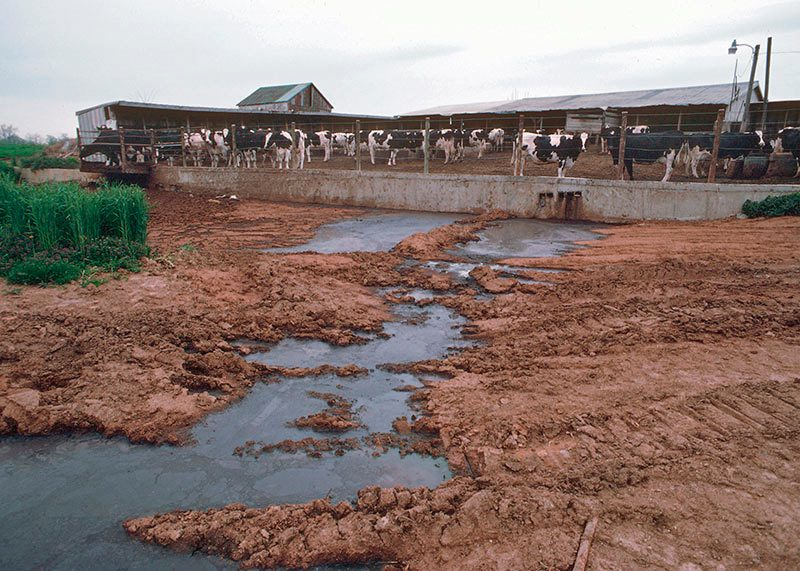 Reasons to Go Vegan #6: Pollution
Reasons to Go Vegan #6: Pollution
 Water And Soil Pollution
Water And Soil Pollution
 Until he extends the circle of his compassion to all living things, man will not himself find peace.
Until he extends the circle of his compassion to all living things, man will not himself find peace.
—Albert Schweitzer
Factory farms—giant livestock farms also known as feedlots that house thousands of cows, chickens or pigs—produce staggering amounts of animal wastes. The way these wastes are stored and used has profound effects on human health and the environment.
A giant factory farm in North Carolina; the brownish rectangle at left is a waste lagoon.
On most factory farms, animals are crowded into relatively small areas; their manure and urine are funneled into massive waste lagoons. These cesspools often break, leak or overflow, sending dangerous microbes, nitrate pollution and drug-resistant bacteria into water supplies. Factory-farm lagoons also emit toxic gases such as ammonia, hydrogen sulfide and methane. What's more, the farms often spray the manure onto land, ostensibly as fertilizer—these "sprayfields" bring still more of these harmful substances into our air and water.
Yet in spite of the huge amounts of animal wastes that factory farms produce, they have largely escaped pollution regulations; loopholes in the law and weak enforcement share the blame. NRDC has fought, and won, a number of courtroom battles over the years to force the federal government to deal with the problem of factory farms, and the U.S. EPA is now under court order to set tighter controls on release of pathogens into the environment by factory farms, exercise greater oversight on factory farms' pollution-reduction plans, and ensure that these plans are made available to the public. —Pollution from Giant Livestock Farms Threatens Public Health
Articles
L.A. Needs to Stop Being Such a Cow Town, Scientific American, 2012.You might not think of Los Angeles as a cow town. But there are nearly 300,000 cattle in the region, according to the U.S. Department of Agriculture. And now flights to measure local air pollution have revealed that the cows may be a bigger factor in dangerous air pollution than the cars are.
Ground-level ozone is bad enough, but smog gets really nasty when it also includes tiny particles of pollution. And the bacteria eating all that dairy cow waste turn out to be as big a source of this type of pollution as L.A.'s nearly 10 million cars and trucks.
The good news: it's a lot easier to control emissions from a few big dairy farms than 10 million vehicles. So an effort to reduce the pollution from cows and their bacteria could have a bigger impact on Los Angelenos air than further emission cuts from cars. So says a study in the journal Geophysical Research Letters.
When It Comes to Toxic Emissions, Chicken Farms Are Worse Than Factories, The Daily Green, 2008."Based on available studies, the broiler producers in the top ten states released an estimated 481.7 million pounds of ammonia in 2007, or more than eight times the combined total reported by industrial sources (e.g., steel mills and refineries) to the EPA's Toxics Release Inventory ... Based on a recent study in Indiana, egg laying operations in the top ten states emitted and estimated 221.6 million pounds of ammonia per year, or nearly three times the amount reported to TRI by all industrial sources combined."
Rearing cattle produces more greenhouse gases than driving cars, UN report warns, UN News Center, 2006.Cattle-rearing generates more global warming greenhouse gases, as measured in CO2 equivalent, than transportation, and smarter production methods, including improved animal diets to reduce enteric fermentation and consequent methane emissions, are urgently needed, according to a new United Nations report released today.
"Livestock are one of the most significant contributors to today's most serious environmental problems," senior UN Food and Agriculture Organization (FAO) official Henning Steinfeld said. "Urgent action is required to remedy the situation."
Cattle-rearing is also a major source of land and water degradation, according to the FAO report, Livestock's Long Shadow?Environmental Issues and Options, of which Mr. Steinfeld is the senior author.
"The environmental costs per unit of livestock production must be cut by one half, just to avoid the level of damage worsening beyond its present level," it warns.
How Meat Contributes to Global Warming, Scientific American, 2009.Most of us are aware that our cars, our coal-generated electric power and even our cement factories adversely affect the environment. Until recently, however, the foods we eat had gotten a pass in the discussion. Yet according to a 2006 report by the United Nations Food and Agriculture Organization (FAO), our diets and, specifically, the meat in them cause more greenhouse gases carbon dioxide (CO2), methane, nitrous oxide, and the like to spew into the atmosphere than either transportation or industry.
Anaerobic Transformation Kinetics and Mechanism of Steroid Estrogenic Hormones in Dairy Lagoon Water —Environmental Science & TechnologyWastewater from concentrated animal feeding operations (CAFOs) frequently contains high concentrations of steroid estrogenic hormones. Release of these hormones into the environment may occur when CAFO wastewater is applied to agricultural lands as a nutrient and water source for crop production. To assess the potential risk of hormone contaminants derived from animal wastewater, we investigated the transformation kinetics and mechanisms of three natural estrogenic hormones.Still not convinced? Listen to these.
For further in depth data
See our Resources pages including books, films, local restaurants and more.
Top ↑

 Your Health
Your Health Physiology
Physiology Abuse/Cruelty
Abuse/Cruelty Dairy
Dairy The Planet
The Planet Veal
Veal Palm Oil
Palm Oil Global Warming
Global Warming Animal Acts
Animal Acts The Ocean
The Ocean Slaughter
Slaughter Wool
Wool Lab Animals
Lab Animals







